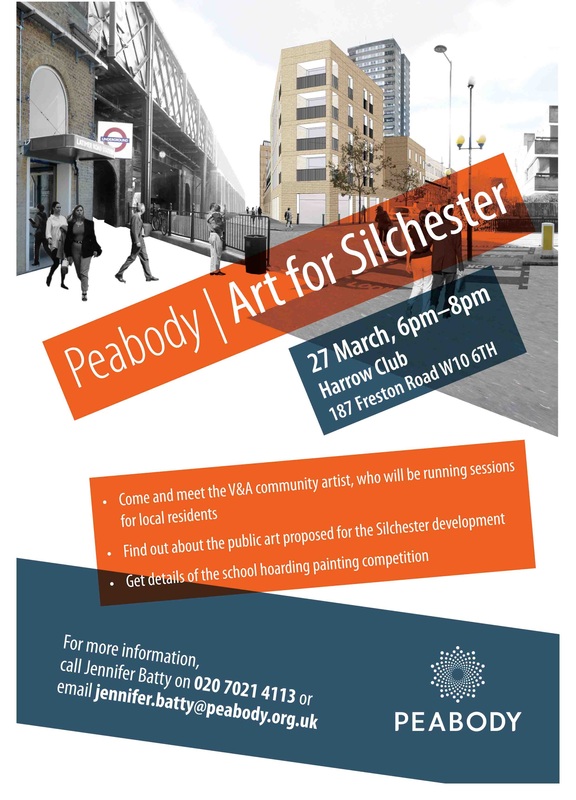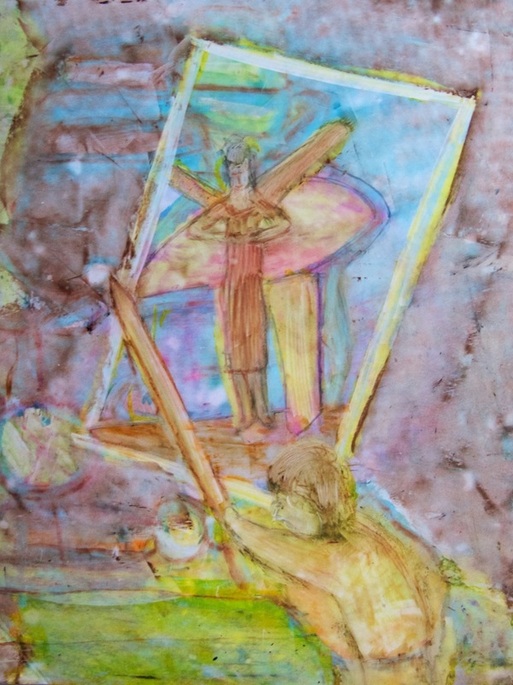|
Please pop down to the Harrow Club on 27th March to find out about exciting art developments in North Kensington.
For a start, I'm delighted to announce my appointment as the Victoria & Albert Museum's first Community Artist in Residence. Although we haven't quite confirmed details, I will hopefully be based in an artists studio on the site, directly opposite Latimer Road tube station. We hope this will be in late summer or autumn for a period of three months. This is a scheme funded by the V&A Museum and RIBA, and supported by Peabody, Hayworth Tompkins and RBKC. Social and community engagement will be the primary focus of my residency. Namely, the creation of art by interaction and dialogue with the local community and to relate this to the new housing development. I propose to run fortnightly, structured sessions with residents, schools and local artists. These might vary from drawing classes, photography, clay making or film making as I propose to work in a variety of media. Residents will have the opportunity to observe work in progress, learn skills and have fun. The studio will also be open for visitors. There will be a range of information about the rich and complex history of the area, including maps, photos and short films. I’m not sure whether my residency will coincide with the arrival of new residents. If so, I would be very keen to liaise between old and new residents. Art used to foster a sense of identity and community. This might be realised in the making of a short film about the housing project and my residency. The residency will be a great opportunity for me to build on the foundations of previous work: Flood Light (2010) and West Ten, Fade Out (2013). Most importantly, the Latymer Mapping Project (2012-13), a collaborative project with group+work and local residents. This produced an alternative community map of North Kensington that focused on historical and contemporary issues related to housing and regeneration. Having a studio adjacent to the new housing will allow me to observe and respond to the construction process. I have a personal interest in this as my father was a carpenter and worked on housing projects from the 1940s - 1980s. I would like to sample some of the materials being used for the construction (brickwork, paints, decorative finishes) and to feature this in art work. As this is also a V&A residency, I will connect with the following collections at the museum: Architecture, Ceramics, Drawings and Photography. It will be a pleasure to have access to specific art objects and the insight of curators. Themes that I might want to explore during my residency include: • how the new housing will contribute to the regeneration of the area • why the Silchester development was commended at the New London Architecture Awards in 2013 • the role of an artist in relation to community and social issues A community artist should also flourish in the company of other artists. I will therefore invite my fellow resident artists at the V&A to share their practice and ideas about engagement, and hopefully work with them on some collaborative projects. There is also an amazing public sculpture being created for the roof of the new building. This will be designed by Nathan Coley. Nathan was shortlisted for the Turner Prize in 2007 and his practice explores how architecture reflects and conditions the social environment. A feast of art making and sharing is coming to North Kensington and the V&A Museum over summer and autumn 2014. I am privileged to be a part of this.
0 Comments
With my eyes closed, I sense her presence and hear a faint murmur, a sound that cascades into a tune.
This is an overdubbed improvisation in memory of Marie Henderson. A footnote in British theatre history, but in her time (1860-1880) and place (Royal Colosseum, Britannia and Elephant and Castle Theatres) she was a potent force in the world of melodrama. This orchestration celebrates the public and private life of Marie Henderson. The first section evokes the power of her performance in the smash hit of 1863: Faith, Hope and Charity. Marie plays Faith, a young clerical widow, cheated out of a property lease and who dies of a broken heart. She returns to haunt the treacherous aristocrat. He repeatedly stabs her image, but as with all good ghosts, she cannot be vanquished. This production employed the latest technological craze of the Victorian stage - Professor Pepper's optical illusion for stage ghosts. Glockenspiel and bells strike notes of tension or release, delicate or harsh surfaces that play off harp, French horn, strings and clarinet. For the finale, we find Marie Henderson in 1882 acting out her death. The actress had contracted syphillis (undiagnosed at the time) and ended her days in Bedlam Hospital with her husband by her side. An electric guitar sets the otherworldly tempo and is a poignant farewell to a theatrical force that had once captured the imagination of Liverpool and London theatre goers. I feel a tremendous affinity with the psychological soundscapes of Nordic music. Reference points for this composition are Sibelius 5th symphony and ECM Records Terje Rypal's Avskjed. Detailed blog entry on Marie Henderson. An anthology of eleven spooky stories "for fearless readers of ten upwards" is being devoured by an eight year old boy.
The book in question is Alfred Hitchcock's Ghostly Gallery. That boy, me. I have a vague memory of a Puffin Book sales rep attending my primary school in 1974. She waxed lyrical about the latest books and left behind a catalogue. After begging 30 pence from home, I placed an order and next week the said book materialised. It had a lovely Ghostbuster cover illustration by the artist, Barry Wilkinson. Literary phantoms and apparitions were conjured from the imaginations of H.G. Wells, Robert Louis Stevenson et al. Was the boy a tad disappointed? There were no contemporary stories in the Hitch style. No Birds or Psycho. For even at this stage in life, Bodega Bay and showers, were etched in my consciousness; a generation breast fed on cinema mediated by television. Schooling intervened to impose a "dubious" (at the time) value of learning by rote. Reading, writing and arrrr-rithmetic! It did however provide a focus to the act of reading. Books. Discreet and unassuming objects. Turn the page. Unleash the inner voice with a tale to tell. Jump cut to secondary education and another memory, this time of an English class. I see a slighter older boy who copies out whole sections of text and passes it off as his own. Copyright? I didn't know the meaning of the word. My teacher rather playfully comments in the margins: Bram Gras or Edgar Allan Gras? Flash forward. Today is World book day in the UK and I'm chilling out with Horror: The Definitve Guide To The Cinema of Fear. A most informative survey of cinematic horror from its origins in gothic literature to postmodernism and beyond. Just the tonic for some extra-curricular research. Cross fade between 1974 and 2014, bookish boy and artful man. Time breeds all manner of change, but I'm still possessed by books (and films) that make the flesh creep. Although the internet has revolutionised book culture and e-books represent the future, I'm hankering for a 1,128 page book published in 2007: Mario Bava: All the Colours of the Dark by Tim Lucas. It retails at about £185. That's a lot of pennies for a humongous bank of piggies. Better still, see if the BFI or the British Library have a copy. End note. I cannot check out books from my local pop-up library in Kensal Rise. This was set up by the local community in resistance to the council closure of the library. In the last few weeks, building works have commenced to convert the building into housing and a skip was summoned to dispose of the books. |
Categories
All
Archives
May 2024
|


 RSS Feed
RSS Feed
